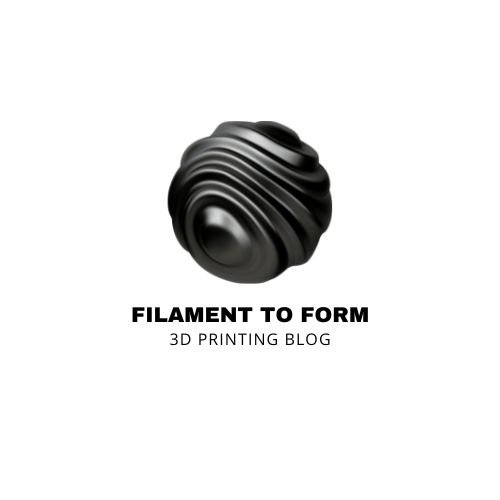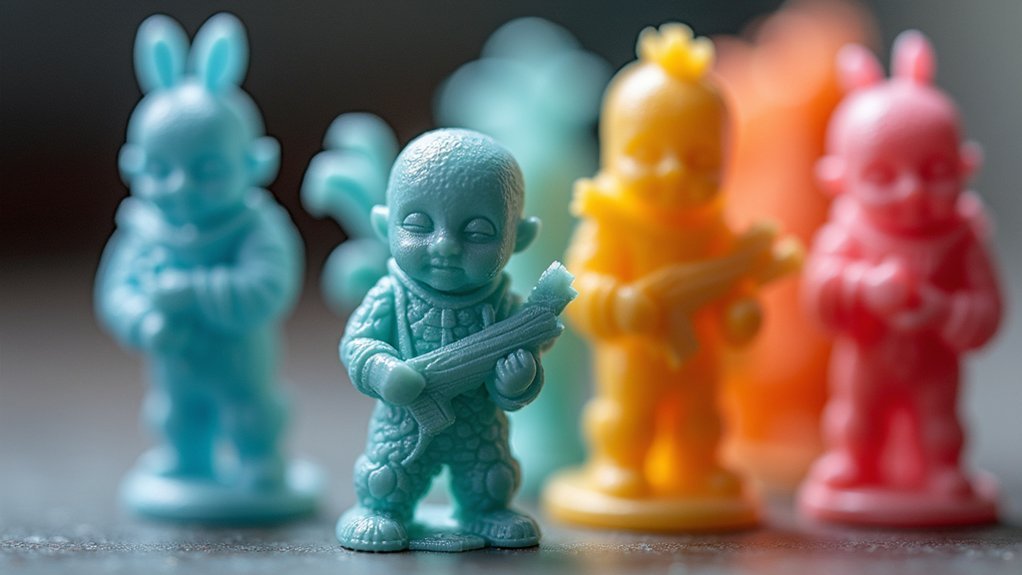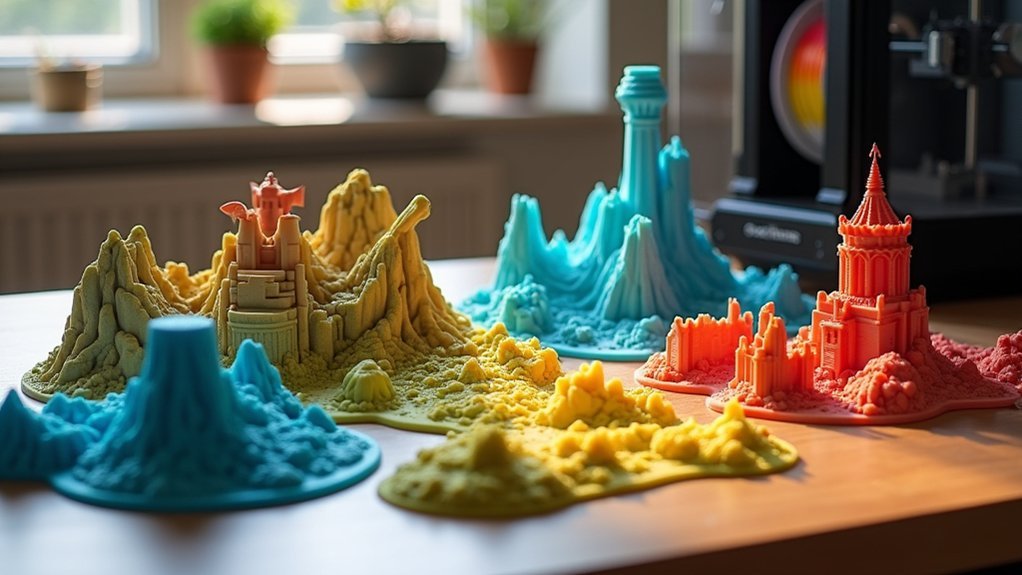You’ve probably spent countless hours scraping prints off your bed, risking damage to both your parts and the surface. Those days of wrestling with stubborn prints can finally end with the right flexible print bed. The secret isn’t just in the material—it’s about finding beds that release parts effortlessly once they cool down. We’ve tested the most popular options to identify which ones truly deliver on their promise of easy part removal.
Double Sided Build Plate for Bambu Lab 3D Printers (257.5×257.5MM Spring Steel)
If you’re running a Bambu Lab printer and need a build surface that handles multiple materials with ease, this double-sided spring steel plate delivers exceptional versatility. Compatible with X1, X1C, X1E, P1P, P1S, and A1 models, it features H1H coating that provides superior adhesion compared to smooth PEI, PET, or PEO surfaces. The H1H alphabet and number design creates vibrant colors under different light angles while enabling double-sided printing. You’ll appreciate the flexible design that lets you simply peel and bend for effortless part removal. Maintenance stays simple with wet tissue or alcohol cleaning.
Best For: Bambu Lab printer owners who need a versatile build surface that handles multiple materials with superior adhesion and want the convenience of double-sided printing with easy part removal.
Pros:
- Superior adhesion compared to smooth PEI, PET, or PEO surfaces ensuring secure model attachment during printing
- Double-sided functionality with H1H alphabet and number design that creates vibrant colors under different light angles
- Flexible spring steel design allows for effortless part removal by simply peeling and bending the plate
Cons:
- Only compatible with specific Bambu Lab printer models, limiting use with other 3D printer brands
- H1H coating may require learning curve to optimize print settings compared to standard PEI surfaces
- Spring steel plates can potentially warp over time with repeated heating cycles and flexing
Ender 3 Spring Steel PEI Bed Plate for Creality Ender 3/Pro/V2/S1/Neo
The Ender 3 Spring Steel PEI Bed Plate transforms your Creality printer experience with its magnetic flexibility that lets you pop off finished prints with a simple bend. This 235mm x 235mm upgrade works with multiple Ender models and handles various filaments including PLA, PETG, and ABS at temperatures exceeding 226℉.
You’ll appreciate the high-quality spring steel construction that resists warping while providing excellent adhesion when clean. Installation’s straightforward as a drop-in replacement, including a magnetic base if needed. Users report four-year lifespans with proper maintenance using isopropyl alcohol cleaning every 3-6 months, making this a reliable long-term solution for easier print removal.
Best For: Creality Ender 3 users who want hassle-free print removal and improved bed adhesion without frequent maintenance or complex installation procedures.
Pros:
- Flexible spring steel allows easy print removal by simply bending the bed surface
- Excellent heat resistance up to 226℉ and compatibility with multiple filament types including PLA, PETG, and ABS
- Long-lasting durability with users reporting 4+ years of reliable performance with basic maintenance
Cons:
- Some users experience initial adhesion issues with the smooth side that may require surface preparation
- Requires regular cleaning every 3-6 months with isopropyl alcohol to maintain optimal performance
- May need additional adhesion aids like hairspray for certain filaments or printing conditions
235×235 Double Sided Textured PEI and Magnetic Bottom Sheet for Ender-3 3D Printers
HICTOP’s 235x235mm double-sided textured PEI bed stands out as an excellent upgrade for Creality printer owners who want versatile printing capabilities without constantly swapping build surfaces. You’ll get excellent adhesion with both sides, eliminating the need for glue or additional tools. The magnetic system makes installation simple—just stick the magnetic sheet to your heated bed and place the flexible steel platform on top.
You’ll achieve superior results at 60℃ for most materials and 80-85℃ for PETG. When your prints finish, they’ll release easily as the bed cools to room temperature. If anything sticks, gentle flexing removes stubborn prints without scraping.
Best For: Creality 3D printer owners who want a versatile, easy-to-use build surface that eliminates the need for adhesives and provides reliable print removal without constant surface swapping.
Pros:
- Double-sided textured PEI surface provides excellent adhesion for multiple materials without requiring glue or additional tools
- Magnetic system allows quick and easy installation and removal of the flexible steel platform
- Prints release easily when cooled to room temperature, with gentle flexing available for stubborn prints
Cons:
- Limited maximum bed temperature of 130℃ may restrict compatibility with high-temperature materials
- Only compatible with specific Creality printer models, limiting versatility for users with other 3D printer brands
- PEI surface may wear down over time with repeated use and flexing for print removal
Textured PEI & Smooth PET Heat Bed Plate (Compatible with Artillery Genius)
Dual-sided functionality makes this Textured PEI & Smooth PET Heat Bed Plate an excellent choice for 3D printing enthusiasts who want versatility without purchasing multiple build surfaces. You’ll appreciate the textured PEI side’s excellent adhesion for PLA, PETG, and TPU filaments, while the smooth PET side delivers visually appealing finishes. The magnetic base attaches easily to your heated bed, and the flexible stainless steel platform lets you pop off prints effortlessly once cooled. Compatible with Artillery Genius and various other printers, this 220×220mm plate maintains magnetism up to 120°C and eliminates glue stick requirements completely.
Best For: 3D printing enthusiasts who want dual-surface versatility for different filament types and print finishes without needing multiple build plates.
Pros:
- Dual-sided design with textured PEI for strong adhesion and smooth PET for aesthetic finishes
- Easy print removal with flexible stainless steel platform and magnetic base system
- Eliminates need for glue stick while maintaining magnetism up to 120°C
Cons:
- Requires bed re-leveling after installation with precise 0.1-0.2mm gap maintenance
- Some users report demagnetization issues requiring re-magnetization over time
- Handle design could be improved for safer handling during print removal
PEI Sheet 235mmx235mm with Magnetic Sticker for Creality Ender 3D Printers
Creality Ender users seeking a hassle-free printing experience will find this PEI sheet with magnetic sticker transforms their workflow completely. You’ll get excellent adhesion at 60℃, then watch prints release effortlessly when the bed cools. No glue or scraping tools needed—simply bend the flexible surface if prints resist removal.
The magnetic installation makes swapping beds quick and easy. You’re getting 75% thicker PEI and 25% thicker spring steel than competitors offer, ensuring durability for continuous printing. Compatible with PLA, PETG, ABS, and PEEK, it handles temperatures up to 120℃. Clean-up requires only isopropyl alcohol or soapy water.
Best For: Creality Ender 3D printer owners who want reliable print adhesion without the hassle of glue or scraping tools, plus the convenience of easy bed removal for print extraction.
Pros:
- Superior build quality with 75% thicker PEI and 25% thicker spring steel compared to competitors for enhanced durability
- Magnetic design allows quick and easy bed swapping without tools or complicated installation
- Works with multiple filament types (PLA, PETG, ABS, PEEK) and provides excellent adhesion at 60℃ with effortless print removal when cooled
Cons:
- Limited to 235mm x 235mm size, restricting compatibility to specific printer models
- Some users report better adhesion with the textured side only, limiting surface options for certain filaments
- Requires heated bed capability and specific temperature control for optimal performance
Factors to Consider When Choosing Flexible Print Beds That Pop Parts Off Easily
When you’re selecting a flexible print bed, you’ll need to evaluate several critical factors that directly impact your printing success. Consider the material quality standards and temperature resistance capabilities to guarantee your bed withstands repeated heating cycles without warping or degrading. You’ll also want to balance adhesion performance with surface texture options while confirming your chosen bed meets your specific printer’s compatibility requirements.
Material Quality Standards
Since the foundation of any reliable flexible print bed lies in its material composition, you’ll want to prioritize spring steel or high-quality PEI surfaces that resist warping and maintain structural integrity over thousands of print cycles. Look for beds that maintain adhesion properties at temperatures up to 120°C, ensuring compatibility with various filament types without performance degradation.
Choose materials with at least 75% thickness compared to standard options—this enhanced durability supports continuous 24/7 printing without deterioration. Consider surface texture carefully: textured surfaces excel with challenging filaments like PETG, while smooth surfaces offer better aesthetics but may complicate part removal. Remember that quality materials require minimal maintenance, typically just isopropyl alcohol cleaning to prevent residue buildup.
Temperature Resistance Capabilities
Although material quality forms the backbone of flexible print beds, temperature resistance capabilities determine whether your investment will perform consistently across diverse printing scenarios. You’ll need beds that handle 60°C for basic PLA printing up to 130°C for high-temperature filaments like ABS and PETG. Quality spring steel plates maintain structural integrity beyond 120°C without warping through repeated heat cycles.
Your bed’s adhesion performance improves considerably at elevated temperatures, with ideal results typically occurring between 60-85°C for most materials. However, you must respect thermal limits—exceeding manufacturer specifications causes demagnetization and adhesion loss, compromising print quality and part removal ease. Choose beds engineered for continuous high-temperature use to maintain long-term performance and consistent part release across various filament types.
Adhesion Performance Balance
Perfect adhesion performance requires striking a delicate balance between holding your prints securely during fabrication and releasing them effortlessly once cooling begins. You’ll want to target heated bed temperatures between 60-85°C for ideal adhesion that prevents warping without requiring additional glue or scraping tools.
High-quality PEI surfaces excel at this balance, providing excellent grip for various filaments while allowing easy removal when cooled. Textured surfaces often outperform smooth ones by gripping prints during the heating phase but releasing upon cooling.
You’ll need to compare different surface types based on your specific filaments. Regular maintenance with isopropyl alcohol cleaning maintains this essential adhesion performance and extends your flexible bed’s lifespan, ensuring consistent results print after print.
Surface Texture Options
Your flexible print bed’s surface texture directly impacts how easily parts pop off after printing. Textured PEI surfaces excel at gripping materials like PLA and PETG during builds while releasing cleanly once cooled. You’ll find textured beds require temperatures around 60℃ for general materials, though PETG performs best at 80-85℃.
Smooth surfaces create superior aesthetic finishes but can make removal challenging. Consider dual-sided flexible beds offering both textures—you’ll switch between textured and smooth sides based on your filament choice and desired finish quality.
Maintain either surface type with regular isopropanol cleaning to preserve adhesion properties and guarantee consistent part release. This simple maintenance routine keeps your flexible bed performing effectively, whether you’re using textured or smooth surfaces for different printing projects.
Printer Compatibility Requirements
Three critical compatibility factors determine whether your flexible print bed will work seamlessly with your 3D printer. First, verify the bed’s specifically designed for your printer model, as proper fit is essential for peak performance. Mismatched dimensions can create gaps or overhang that compromise print quality and safety.
Second, confirm the build area measurements match your printer’s specifications exactly. Even slight size variations can prevent proper installation or cause leveling issues that affect your prints.
Third, consider the bed material’s compatibility with your printer type and preferred filaments. Some materials work better with specific brands or heating elements, directly impacting adhesion and part release. Research user reviews from owners of your exact printer model, as real-world experiences often reveal compatibility issues that product descriptions miss.
Maintenance and Durability
Beyond ensuring compatibility with your printer, flexible print beds require specific maintenance practices to deliver long-lasting performance. You’ll need to clean your bed regularly with isopropyl alcohol or warm soapy water to maintain ideal adhesion and prevent residue buildup that compromises print quality.
Quality flexible beds withstand high temperatures up to 130°C, making them durable across various filament types. You’ll find that thicker PEI and spring steel materials offer superior longevity, with some lasting over two years without deterioration.
To maximize your bed’s lifespan, avoid harsh chemicals and maintain a clean surface consistently. When you follow proper care routines, you’ll enjoy easy print removal through gentle flexing once the bed cools to room temperature.
Frequently Asked Questions
How Long Do Flexible Print Beds Typically Last Before Needing Replacement?
You’ll typically get 6-12 months from flexible print beds with regular use. Heavy printing, aggressive removal, or high temperatures can shorten their lifespan. You’ll notice decreased adhesion when it’s time to replace.
Can Flexible Beds Handle High-Temperature Filaments Like PETG and ABS Safely?
You’ll find most flexible beds handle PETG and ABS temperatures safely, typically withstanding 80-100°C. However, you should always check your specific bed’s temperature rating before printing high-temp filaments to avoid damage.
Do Flexible Print Beds Affect Print Quality Compared to Glass Beds?
You’ll find flexible beds maintain excellent print quality comparable to glass beds. They provide consistent first layer adhesion and smooth surface finishes. You won’t sacrifice quality when switching from glass to flexible options.
How Do You Properly Clean and Maintain Flexible PEI Surfaces?
You’ll need isopropyl alcohol and a microfiber cloth for routine cleaning. For stubborn residue, use acetone sparingly. Avoid abrasive materials that’ll scratch the surface. Clean between prints and store properly to maintain adhesion.
Are Flexible Beds Compatible With Auto Bed Leveling Sensor Systems?
You’ll find most flexible beds work perfectly with auto-leveling sensors. The key’s ensuring your bed’s thickness matches your sensor’s detection range. Inductive sensors work great with steel-backed flexible sheets, while capacitive sensors handle various materials.





Leave a Reply